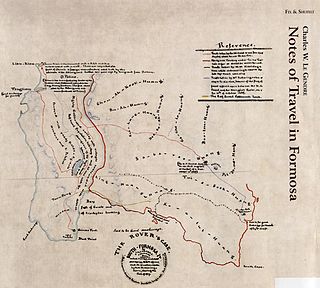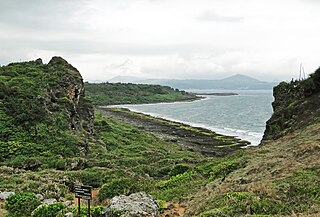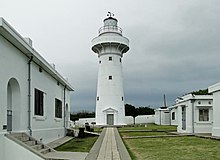
The Taiwan Strait is a 180-kilometer -wide strait separating the island of Taiwan and continental Asia. The strait is part of the South China Sea and connects to the East China Sea to the north. The narrowest part is 130 km wide.

The Rover Incident occurred on 12 March 1867 when the American merchant ship Rover, captained by Joseph Hunt who was accompanied by his wife Mercy G. Beerman Hunt, and en route from Shantou to Niuzhuang, was wrecked off the coast of Taiwan, then ruled by the Qing dynasty. The ship struck a coral reef called Qixingyan near Cape Eluanbi and drifted into the area of Kenting in modern-day Hengchun, Pingtung County, Taiwan. Fourteen American sailors, including Hunt and his wife, were killed by Taiwanese Aborigines in revenge for earlier killings of Kaolut (Koalut/Ku-a-lut/etc) tribe members by foreigners. Subsequently, the U.S. military decided to send a military expedition against the tribe members responsible.

Gongliao District is a rural district in the eastern part of New Taipei City, Taiwan. It is the easternmost district on the main island of Taiwan and at its easternmost tip is Cape Santiago.

Ruifang District is a suburban district in eastern New Taipei City, Taiwan.

Kenting National Park, commonly known as Kenting, is a national park located on the Hengchun Peninsula of Pingtung County, Taiwan, covering Hengchun, Checheng, and Manzhou Townships. Established on 1 January 1984, it is Taiwan's oldest and the southernmost national park on the main island, covering the southernmost area of the Taiwan island along Bashi Channel. Administered by the Executive Yuan's Ministry of the Interior, this national park is well known for its tropical climate and sunshine, scenic mountain and beach, the Spring Scream rock-band festival held in every March, and has long been one of the most popular tourist destinations in Taiwan with 5.84 million visitors in 2016.

Cape Santiago is a cape on the easternmost point of the island of Taiwan, located in the Gongliao District, New Taipei City.

Cape Eluanbi or Oluanpi, also known by other names, is the southernmost point on the island of Taiwan. It is located in Eluanbi Park within the Hengchun Township in Pingtung County.

Hengchun Township is a township located on the southern tip of the Hengchun Peninsula in Pingtung County, Taiwan. It is the southernmost township in Taiwan. Hengchun is also the only urban township in the southern part of Pingtung County. Hengchun has a land area of 136.76 km2 (52.80 sq mi) and has a population of 29,821 as of March 2023.

The Japanese punitive expedition to Taiwan in 1874, referred to in Japan as the Taiwan Expedition and in Taiwan and Mainland China as the Mudan incident, was a punitive expedition launched by the Japanese ostensibly in retaliation for the murder of 54 Ryukyuan sailors by Paiwan aborigines near the southwestern tip of Taiwan in December 1871. In May 1874, the Imperial Japanese Army and Imperial Japanese Navy attacked the indigenous Taiwanese peoples in southern Taiwan and retreated in December after the Qing dynasty agreed to pay an indemnity of 500,000 taels. Some ambiguous wording in the agreed terms were later argued by Japan to be confirmation of Chinese renunciation of suzerainty over the Ryukyu Islands, paving the way for de facto Japanese incorporation of the Ryukyu in 1879.

Qilaibi Lighthouse is a lighthouse in Qilaibi, Hualien City, Hualien County, Taiwan. Today the lighthouse is overseen by the Customs Administration of the Ministry of Finance. The lighthouse is built between the Central Mountain Range and the Pacific Ocean. The lighthouse is not open to the public all year around.
Articles related to Taiwan include:

The Eight Views of Taiwan have been variously defined throughout Taiwan's history.

The Formosa Expedition, or the Taiwan Expedition of 1867, was a punitive expedition launched by the United States against the Paiwan, an indigenous Taiwanese tribe. The expedition was undertaken in retaliation for the Rover incident, in which the Rover, an American bark, was wrecked and its crew massacred by Paiwan warriors in March 1867. A United States Navy and Marine company landed in southern Taiwan and attempted to advance into the Paiwan village. The Paiwan responded with guerrilla warfare, repeatedly ambushing, skirmishing, disengaging and retreating. Eventually, the Marines' commander was killed and they retreated to their ship due to fatigue and heat exhaustion, and the Paiwan dispersed and retreated into the jungle. The action is regarded as an American failure.

South Bay, also known by other names, is a bay and adjacent beach near Hengchun in Pingtung County, Taiwan. It is part of Kenting National Park.

The Fuguijiao or Cape Fugui Lighthouse is a lighthouse on Cape Fugui near Laomei Village (老梅里,Lǎoméi Lǐ) in Shimen District, New Taipei City, Taiwan.

Cape Fugui, Cape Fukwei, Fukwei Chiao, Fuguei Cape, or Fugui Cape is a cape located at the northernmost point of the island of Taiwan. It is located in Cape Fugui Park within the Shimen District in New Taipei City.

The Bitou Cape is a cape in Ruifang District, New Taipei, Taiwan.
Crotalaria similis, also known as the Pingtung Curara pea, belongs to the family Fabaceae and genus Crotalaria. It is a perennial crawling herb, an endemic species of Taiwan which the distribution is limited to the Eastern seaside of the Hengchun Peninsula.

























